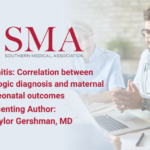Abstract | November 12, 2020
Chorioamnionitis: Correlation between clinical vs histologic diagnosis and maternal and neonatal outcomes
Learning Objectives
- Examine the correlation between clinical indicators of chorioamnionitis during labor and histologic diagnosis of chorioamnionitis.
- Recognize antepartum and intrapartum risk factors associated with chorioamnionitis.
- Discuss the implications for empiric treatment with antibiotics during labor when clinical risk factors for chorioamnionitis are present.
Background: Chorioamnionitis diagnosed during labor based on clinical criteria (mainly fever) is aggressively treated with antibiotics to prevent maternal/neonatal morbidity. However, factors other than infection could result in fever during labor. This study aims to determine whether clinically diagnosed chorioamnionitis is histologically confirmed, and thus antibiotics is justified, and to describe maternal/neonatal outcomes from either clinical or histologic diagnosis.
Methods: A retrospective analysis was performed on data collected on patients diagnosed with chorioamnionitis (either clinical or histologic). Student t-test and Chi-square analysis were performed on maternal/neonatal outcomes with P < 0.05 being significant.
Results: 395 patients were diagnosed with chorioamnionitis; 36.7% diagnosed clinically and confirmed by placenta histology, 4.4% diagnosed clinically but not confirmed by histology, 15% diagnosed clinically but placenta was not examined, and 50.9% diagnosed by incidental placenta histology. Those diagnosed clinically and confirmed by histology are more likely than those incidentally diagnosed by histology to deliver at older gestation (38.2 +/- 2.5 vs 37.4 +/- 4.0 weeks; p<0.001), to have intrapartum fever (77.6% vs 7.0%, p 0.000), maternal tachycardia (79.8% vs 53.7%, p 0.000), fetal tachycardia (54.5% vs 4.8%, p 0.000), maternal leukocytosis (69.7% vs 50.0%, p 0.001), uterine tenderness (12.1% vs 0, p 0.000), purulent discharge (15.5% vs 2.1%, p 0.000), drop in hct postpartum (5.6 vs 4.9, p 0.014), and to receive epidural (98.4% vs 88.1%, p 0.000), cytotec (20% vs 10%, p 0.012), Pitocin (98.4% vs 88.1%, p 0.000), internal monitoring (23.9% vs 8.0%, p 0.000), and antibiotics (96.8% vs 2.0%, p 0.000) but less likely to be GBS carrier (26.9% vs 39.1%; p 0.05); their neonates had lower 1-minute Apgar score (5.9 vs 7.1, p 0.005), higher NICU admission (85.4% vs 40%, p 0.000), sepsis workup (86.7% vs 37.9%, p 0.000), and empiric antibiotic treatment (83.3% vs 30.0 %, p 0.000).
Conclusions: Clinical chorioamnionitis sometimes was not confirmed by histology, pointing to other potential causes for intrapartum fever besides infection. Conversely, many histologic diagnoses of chorioamnionitis were not associated with clinical symptoms, possibly suggesting subclinical chorioamnionitis.

